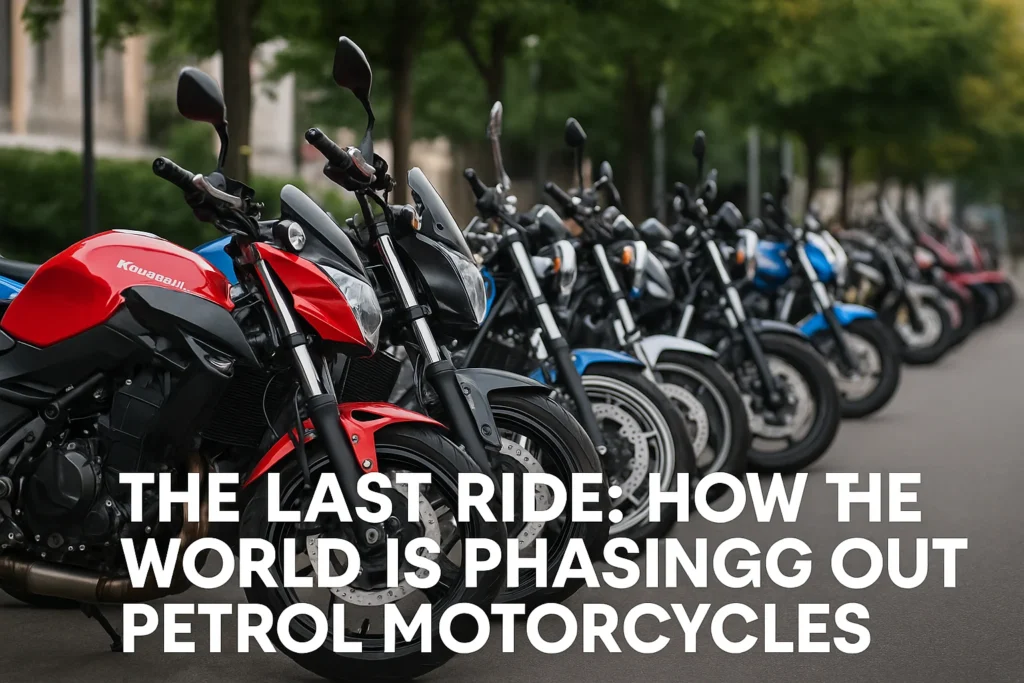The Dawn of a New Era in Personal Transportation
In the bustling streets of Jakarta, a profound transformation is underway. At sunrise, the familiar cacophony of sputtering two-stroke engines that has defined Indonesian mornings for generations is being replaced by an eerie quiet. Food delivery riders, once astride smoking Yamahas and Hondas, now glide silently on electric scooters. This scene repeats itself across the globe, from the narrow alleys of Hanoi to the broad boulevards of Paris, marking the beginning of the end for the petrol-powered motorcycle era.
The Driving Forces Behind the Global Shift
Environmental Imperatives
The case against internal combustion engine (ICE) motorcycles has become undeniable:
Air Pollution Crisis
- In Delhi, two-wheelers account for 56% of vehicular PM2.5 emissions
- Bangkok’s motorcycle exhaust contributes to 42% of traffic-related NOx emissions
- Mexico City’s ozone levels near motorcycle corridors exceed WHO limits by 300%
Climate Impact
- The global motorcycle fleet emits 450 million tons of CO2 annually
- A typical 150cc scooter produces 1.5 tons of CO2 per year
- Motorcycle emissions are growing 3.2% annually in developing nations
Noise Pollution
- Petrol motorcycles generate 85-95 dB at full throttle (WHO recommends <55 dB)
- In European cities, 68% of noise complaints involve two-wheelers
- Chronic noise exposure increases heart disease risk by 8%
Technological Advancements Enabling Transition
Battery Technology Leap
- Energy density improved 300% since 2010
- Charge times reduced from 8 hours to 15 minutes for 80% capacity
- Costs fallen from $1,200/kWh (2010) to $132/kWh (2024)
Performance Parity Achieved
| Metric | 2020 E-Bike | 2025 E-Bike | Petrol Equivalent |
|---|---|---|---|
| 0-60 km/h | 7.8s | 3.5s | 5.2s |
| Range | 90km | 210km | 250km |
| Maintenance Cost | $0.08/km | $0.05/km | $0.12/km |
Global Policy Landscape
National Phase-Out Plans
| Country | Policy Start | Full Ban | Key Incentives | Challenges |
|---|---|---|---|---|
| France | 2024 | 2035 | €2,500 trade-in bonus | Vintage bike lobby |
| India | 2023 | 2030 | 25% manufacturer tax break | Charging infrastructure |
| Indonesia | 2025 | 2040 | Oil subsidy conversion | Island electrification |
| Colombia | 2024 | 2035 | Free public charging | Mountain terrain |
| Nigeria | 2026 | 2040 | Local assembly grants | Fuel smuggling |
The European Union’s Comprehensive Approach
The EU’s 2035 ICE ban includes motorcycles with:
- Staged CO2 reduction targets (45% by 2025, 90% by 2030)
- Battery recycling mandates (95% recovery rate)
- Urban zero-emission zones expanding annually
The Electric Motorcycle Ecosystem
Charging Infrastructure Development
Innovative Solutions Emerging
- Gogoro’s battery swap stations (400,000 daily swaps in Taiwan)
- Solar-powered roadside chargers in rural Africa
- Induction charging lanes in Oslo pilot program
Global Charger Density
| Region | 2024 Status | 2030 Target |
|---|---|---|
| Western Europe | 1:18 bikes | 1:5 |
| Southeast Asia | 1:127 | 1:25 |
| Sub-Saharan Africa | 1:410 | 1:100 |
Battery Technology Roadmap
Next-Generation Developments
- Solid-state batteries (500km range by 2027)
- Sodium-ion alternatives (eliminating lithium dependence)
- Vehicle-to-grid integration (stabilizing renewable grids)
Economic Impacts and Market Transformation
Industry Restructuring
Traditional Manufacturers Pivoting
- Honda investing $4B in solid-state battery production
- Harley-Davidson spinning off electric division as “LiveWire”
- Bajaj converting 60% of production lines to electric
New Market Entrants
- Vietnamese startup VinFast capturing 18% SE Asia market
- Kenya’s Roam building $1,000 solar-charged bikes
- China’s NIU dominating global scooter sharing fleets
Employment Shifts
Growth Sectors
- Battery technicians (200% salary increases in Vietnam)
- Charging infrastructure installers
- Software engineers for bike-sharing platforms
Declining Sectors
- Carburetor specialists (85% reduction in training programs)
- Exhaust system manufacturers
- Lubricant blenders
Cultural and Social Dimensions
The Psychology of Change
Generational Divide
- Under 35s: 72% welcome transition
- Over 50s: 29% support bans
Rider Identity Evolution
- Harley’s “e-Rumble” artificial engine sound option
- New electric racing leagues gaining popularity
- Vintage ICE bike collector market booming
Urban Landscape Transformation
Soundscape Changes
- Paris records 11 dB reduction in central districts
- Rome reports return of bird songs to major avenues
- Bangkok residents report better sleep quality
Visual Changes
- Disappearing gas stations repurposed as cafes/charging hubs
- Reduction in roadside oil stains
- Less visible air pollution haze
Implementation Challenges and Solutions
Infrastructure Hurdles
Urban Solutions
- Singapore’s underground charging network
- Amsterdam’s canal-side floating stations
- Tokyo’s convenience store partnerships
Rural Adaptations
- India’s solar-powered village charging kiosks
- African mobile battery swap vans
- South American donkey-assisted charging for remote areas
Economic Transition Support
Retraining Programs
- Vietnam’s 10,000 mechanic certification initiative
- EU’s Just Transition Fund for motorcycle industry workers
- India’s “E-Mobility Entrepreneur” grants
Financial Incentives
- France’s €2,500 trade-in bonus
- California’s $1,000 low-income buyer credit
- Indonesia’s oil subsidy conversion to charging vouchers
Case Studies of Successful Transitions
Taipei: The Gogoro Effect
After implementing comprehensive battery swap infrastructure:
- 92% of delivery riders converted to electric
- Airborne lead levels dropped 78%
- Rider savings average $600/year on fuel
Bangalore: Electric Rickshaw Revolution
Following aggressive phase-out policy:
- 250,000 petrol autos replaced
- PM2.5 levels near schools down 63%
- Driver incomes increased 30% (lower operating costs)
Oslo: The Silent City Experiment
After implementing ICE motorcycle ban in city center:
- Noise complaints reduced 82%
- Electric bike share up 400%
- Tourism satisfaction scores increased
The Future of Personal Mobility
2025-2030: The Tipping Point
Projected Milestones
- 2026: Electric bike TCO cheaper than petrol globally
- 2027: Solid-state batteries commercialized
- 2028: 50% of global two-wheeler sales electric
- 2029: First “ICE-free” days in major cities
2030-2035: The Final Phase
Endgame Scenarios
- Last petrol models become collector’s items
- Remaining fuel stations converted
- “Sound museums” preserving engine audio heritage
- Final generation of ICE mechanics retires
Voices from the Revolution
The Early Adopter
“I haven’t visited a gas station in three years,” marvels Sofia Chen, a Taipei delivery rider. “I charge while eating lunch – it’s freedom.”
The Reluctant Convert
“I miss the rumble between my legs,” admits Rome courier Marco Bellini. “But not the weekly €50 fuel bill.”
The Entrepreneur
“We’re building Africa’s electric future,” says Kenyan startup founder Eric Muthomi, showing his solar-powered bike factory.
The Nostalgist
“My 1972 Triumph will be my forever bike,” declares British collector James Wilson. “Some things shouldn’t disappear completely.”
The Bigger Picture: Lessons for Other Transitions
Policy Insights
- Early incentives crucial for adoption
- Infrastructure must precede bans
- Cultural attachment underestimated
Business Opportunities
- Second-life battery applications
- Retrofitting services for classic bikes
- New riding experience innovations
Social Considerations
- Equity in transition (poor riders last to benefit)
- Skills transfer programs essential
- Community engagement vital
Epilogue: The Road Ahead
As the sun sets over Jakarta’s suddenly quiet streets, the implications of this global shift become clear. The electric motorcycle revolution represents more than just a change in propulsion technology – it’s a fundamental reimagining of urban mobility, environmental responsibility, and even our sonic landscape.
The challenges remain substantial: charging deserts in developing nations, black markets for petrol bikes, and the inevitable loss of some cultural touchstones. Yet the benefits – cleaner air, quieter cities, and reduced climate impact – suggest this transition, while complex, is both necessary and inevitable.
In garage workshops from Milan to Mumbai, a new generation of mechanics is learning to service battery packs rather than carburetors. On city streets once dominated by the smell of exhaust, children now play in cleaner air. And in government offices worldwide, policymakers are watching this unprecedented transition unfold, learning lessons that may soon apply to other sectors.
The era of the petrol motorcycle is ending not with a bang, but with a quiet hum – and the world may be better for it.



